Today, businesses and their internal culture are defined by the pervasive workflows used across their organization and business apps, and with their customers and partners. These workflows follow the set of steps that must happen to get a job done, like onboarding a new customer or hiring a new employee.
Companies are beginning to realize the value of using tools like Slack not only for messaging and collaboration, but as a console for getting work done. But what kinds of workflows can you do from Slack and what is the best way to create them? In the wake of Slack’s revamped Workflow Builder, let’s take a look at all available options.
Related: The best Slack automations for any organization
The emergence of Slack as the new collaboration platform for digital workers
Like Salesforce and Workday for CRM and HR, Slack has emerged as a leading platform for collaboration, one where employees get their work done. With its powerful collaboration API and Workflow Builder, Slack can be so much more than just sending messages between team members. By putting together Slack capabilities like the events API, message buttons, and the Slack dialogs, collaboration has become more structured than ever before. With this, Slack can now be used as the user interface for complex automations that involve workflows inside and out of Slack.
The rapid growth of Slack as a cornerstone of collaboration has created both opportunities and confusion around the ‘right’ way to implement workflows in Slack – from custom coding with Slack APIs to using purpose-built Slack Apps, bots, or no-code workflow tools.
Given how pervasive workflows are across an organization, it’s clear that they must get automated quickly and be adjusted easily. For this reason, we find that no-code workflow that can be built by business users and easily integrated with common business apps is the best approach.
We applaud Slack for launching and revamping its own native no-code Workflow Builder. This underscores the important role workflows play in delivering on the enterprise console vision. It also validates that the no-code automation approach is the preferred approach and in line with the vision Slack has for enterprise workflows.
The 3 types of Slack workflows
There are 3 distinct categories of workflows in the Slack ecosystem.
Category #1: Native Workflows inside of Slack
There are many interactions within Slack itself that benefit from more structured workflows.
- Bots that execute pre-built workflows inside Slack: To Do, Polly, Attendance Bot, DecisionBot, and Time Bot, for example.
- Using the Slack platform API, developers can build their own structured workflows within Slack.
- Slack’s Workflow Builder, which makes it possible for non-developers to build structured workflows within Slack.
It’s worth noting that any member of a workspace—with the exception of guests—can create their own workflows using the builder; while every member of the channel can leverage those that are live (this includes guests, if it’s a shared channel).
Note: Slack has pre-built workflows that you can use as is or customize to meet your needs—from automatically welcoming new channel members to approving travel requests to scheduling messages in the future.

Native Slack Workflows stay inside of Slack. You can take actions from Slack and the action will do something within Slack itself – say create a poll or serve a pre-written message.
To better contrast the 3 workflow categories, we’ll explore a specific scenario: Employee Onboarding in HR. Slack highlights “streamlining the process of onboarding a new employee to the company, guiding them through tax documents to sign, guides to read, and people to meet” as a native Slack workflow. Everything stays inside of Slack. That’s the first category of Slack workflows.
Category #2: Taking Actions in Apps from Slack
The second kind of Slack workflow leverages Slack as a tool to take actions in, another SaaS app – not within Slack. The Slack integration that the company VictorOps created to let users take action on VictorOps alerts from Slack is a great example. This is a workflow that lives outside of Slack but leverages Slack as the interface.

Sticking with our HR scenario, an example would be processing time-off approvals that happen when an employee wants to go on a vacation. This process happens in the Workday HR app, but allowing the events required to ask and receive the time-off approval to be completed without ever leaving Slack is an example of category #2. This is what things like Workday’s Slack app would enable.
It’s worth noting that Slack’s recently-enhanced Workflow Builder aims to help users with this category of workflow. More specifically, the builder now offers building blocks, which enable users to drag-and-drop a string of actions in widely-used apps that, taken together, comprise a task.
Related: A guide to implementing approval workflows
Category #3: End-to-End Workflows with Slack

This brings us to category #3, which is about workflows that work across any of your applications, data, and teams, while leveraging Slack for user interactions.
With Native Slack Workflows (category #1), you can guide users through HR onboarding documents within Slack. Taking actions outside of Slack (category #2), you can do time-off requests in Workday HR without leaving Slack. And by working across apps, data, and teams (category #3), you can onboard an employee.
For example, when a new employee is created in Workday HR, a direct message to the Hiring Manager requests what to provision the new employee in Slack, then creates a ticket in ServiceNow and, after an approval action in Slack, automates the provisioning of accounts for the employee in Microsoft Active Directory.
An integration and automation platform like Workato, which has a tight integration with Slack, is a Slack workflow tool that can be used to implement such a scenario. And there are many other examples of category #3 inside an enterprise:
- End-to-end help desk process with self-service, ticket submission, and collaborative resolution. Tenable, a leading cybersecurity company, has implemented this.
- Opportunity-to-cash business process with discount approvals and escalated order expedition in Slack
- Intelligent Lead routing
- Security incident validation by colleagues close to a suspected employee
Typically, such workflows are mission-critical and require Enterprise-grade capabilities for handling high volumes of incidents, managing errors, providing process visibility etc. That’s what an Enterprise-grade Enterprise Automation platform like Workato provides.
The role of neutral workflow automation platforms in today’s digital business
Most business apps are, at their core, sets of pre-built workflows that automate the work people do. All of the major SaaS apps like Salesforce, Workday, ServiceNow, and Oracle, are also platforms (for CRM, HR, IT and Finance respectively) — they come with their own no-code workflow engines that allow non-technical app admins to create custom workflows to exactly how they want their business to work. Examples of such workflow engines are Process Builder from Salesforce, Flow from ServiceNow, Journeys from Workday and Workflow from Oracle. But what about creating workflows between different apps?
The explosion of SaaS apps has created information silos of customer, partner, employee, product, financial, and other business data across dozens of apps. Companies also have fragments of customer-facing workflows and other business processes being completed in different apps. Slack can be a great UI for bringing this information together.
In order to utilize Slack in this way, as well as enable cohesive customer facing workflows, enterprises need powerful, neutral workflow tools that:
- Orchestrate business processes across multiple enterprise apps – There are 1000+ SaaS, on-prem, and legacy apps that large companies typically use.
- Have enterprise-grade capabilities – This requires things like automated error handling, data cursors to filter duplicate data, and a guarantee of no data loss.
- Enforces the company’s security and privacy policies within Slack – For example, workflows must follow the enterprise security policies so only specified users in a Slack workspace have access to certain types data or workflows.
- Can be used by non-technical business users like app admins or SalesOps, not just developers, to create and change workflows that span multiple apps
There is a revolution happening in the way work gets done. The vanguard of this movement is enterprise collaboration tools like Slack, along with workflow automation tools that defragment the employee work experience across apps. At Workato, we are excited to play our part in this revolution – enabling cross-application integration and enterprise-grade workflow automation from Slack.
“Workato welcomes continual improvements to Slack’s Workflow Builder, as it validates that no-code tooling is what the market demands,” says CEO of Workato, Vijay Tella. “Workflow Builder’s native workflows in Slack are an exciting complement to Workato’s enterprise workflows across apps and will make experiences like employee onboarding even more beautiful,” he continues. “For instance, you can use Slack’s Workflow Builder to automate the tasks a new employee must do as part of their onboarding; while using Workato to do approvals, as well as onboarding and offboarding workflows across apps like Greenhouse, Workday, ServiceNow, Okta and Active Directory with Slack as the unified UI for all stakeholders involved.”
